Myrna Loy (1905-1993) was an American film, television and stage actress. She was originally typecast in exotic roles, often as a vamp or a woman of Asian descent, but her career prospects improved greatly following her portrayal of Nora Charles in The Thin Man (W.S. Van Dyke, 1934). Suddenly she was the 'Queen of the Movies' and remained so until the late 1940s.

British postcard in the Picturegoer Series, London, no. 355a.
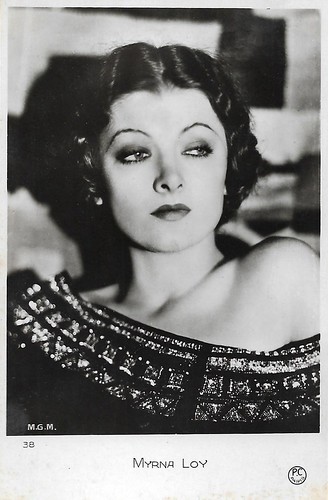
French postcard by P.C., Paris, no. 38. Photo: George Hurrell, c. 1932 / MGM.

British postcard in the Film Partners Series, London, no. P 161. Photo: Metro-Goldwyn-Mayer. William Powell and Myrna Loy in Evelyn Prentice (William K. Howard, 1934).

German postcard by Ross Verlag, no. A 1496/1, 1937-1938. Photo: Metro-Goldwyn-Mayer.

French postcard by Editions P.I., Paris, no. 234, presented by Victoria, Brussels, no. 639. Photo: Metro Goldwyn Mayer (M.G.M.), 1950.
Myrna Loy was born Myrna Adele Williams in 1905 in Helena, Montana. Her parents were Adelle Mae (Johnson) and David Franklin Williams Loy was raised in rural Radersburg during her early childhood. Her mother was a talented pianist who encouraged Myrna's interest in the arts. When she was thirteen, Myrna's father died of influenza in the Spanish Flu epidemic, and the rest of the family moved to Los Angeles.
There, she began studying dance and trained extensively throughout her high school education. At the age of 15, she appeared in local stage productions to help support her family. She appeared in staged prologues before the films in the famous Grauman's Egyptian Theater in Hollywood. During this period, Loy saw Eleonora Duse in the play 'Thy Will Be Done', and the simple acting techniques she employed made such an impact on Loy that she tried to emulate them throughout her career.
Portrait photographer Henry Waxman took several pictures of her that were noticed by Rudolph Valentino when the actor went to Waxman's studio for a sitting. Valentino was looking for a leading lady for Cobra, the first independent project he and his wife Natacha Rambova were producing. Loy tested for the role, which went to Gertrude Olmsted instead. Rambova hired Loy for a small but showy role opposite Nita Naldi in What Price Beauty? (Tom Buckingham, 1925-1928), a film she was producing. Shot in May 1925, the film remained unreleased for three years, but stills of Loy in her exotic makeup and costume appeared in Motion Picture magazine and led to a contract with Warner Bros. There, her surname was changed from Williams to Loy.
At Warner Bros., she began obtaining small roles, mainly portraying vamps or femmes fatales. She appeared along with Zasu Pitts and Joan Crawford in Pretty Ladies (Monta Bell, 1925). She also frequently portrayed characters of Asian or Eurasian background in films such as Across the Pacific (Roy Del Ruth, 1926) starring Monte Blue.
Finally, in 1927, she received star billing in Bitter Apples (Harry O'Hoyt, 1927). The excitement was short-lived as she returned to the usual smaller roles afterward. When her contract ran out with Warner, she signed with MGM where she got better roles.

British Real Photograph postcard by Sarony, no. 40. Photo: Warner Bros. Caption: No. 40 of a second Series of 42 CINEMA STARS issued with Sarony Cigarettes.

Italian postcard by Cinema-Illustrazione, Milano, no. 7, Serie I. Photo: Fox Film. Myrna Loy in Isle of Escape (Howard Bretherton, 1930).

Dutch postcard. Photo: Max Munn Autrey / Fox-Film.

German collector card in the Moderne Schönheitsgalerie series, no 149 (out of 300). The series was produced by Ross Verlag for Kurmark as a supplement for their Edelzigarette. Photo: Metro Goldwyn Mayer (M.G.M.). Myrna Loy in The Mask of Fu Manchu (Charles Brabin, 1932). She played the depraved sadistic daughter of the title character, played by Boris Karloff.

Dutch postcard, no. 484. Photo: Metro-Goldwyn-Mayer. Ramon Novarro and Myrna Loy in The Barbarian (Sam Wood, 1933).
Myrna Loy's role in The Thin Man (W.S. Van Dyke, 1934) with William Powell helped elevate her reputation as a versatile actress. Director W.S. Van Dyke chose Loy after he detected a wit and sense of humour that her previous films had not revealed. At a Hollywood party, he pushed her into a swimming pool to test her reaction and felt that her aplomb in handling the situation was exactly what he envisioned for Nora. Her witty perception of situations gave Loy the image that one could not pull a fast one over on the no-nonsense Mrs. Charles.
The Thin Man became one of the year's biggest hits and was nominated for the Academy Award for Best Picture. From then on, Myrna was a big box office draw. She was popular enough that, in 1936, she was named 'Queen of the Movies' and Clark Gable the king in a nationwide poll of filmgoers. She reprised the role of Nora Charles five more times. William Powell and she proved to be a popular screen couple and appeared in 14 films together, one of the most prolific pairings in Hollywood history. Such films as Wife vs. Secretary (Clarence Brown, 1936) with Clark Gable and Jean Harlow, and Petticoat Fever (George Fitzmaurice, 1936) with Robert Montgomery allowed her to develop her comedic skills. She appeared in two Best Picture Academy Award winners: The Great Ziegfeld (Robert Z. Leonard, 1936) and The Best Years of Our Lives (William Wyler, 1946).
With the outbreak of World War II, Loy focused on the war effort and began devoting her time to working with the Red Cross. Earlier, she was so fiercely outspoken against Adolf Hitler that her name appeared on his blacklist, resulting in her films being banned in Germany. After the war, Myrna Loy was paired with Cary Grant in David O. Selznick's The Bachelor and the Bobby-Soxer (Irving Reis, 1947), co-starring a teenaged Shirley Temple. Following its success, she appeared again with Grant in Mr. Blandings Builds His Dream House (H.C. Potter, 1948). Loy's career began to slow in the late 1940s.
She appeared in only a few films in the 1950s, including a lead role in the comedy Cheaper by the Dozen (Walter Lang, 1950) opposite Clifton Webb, as well as supporting parts in The Ambassador's Daughter (Norman Krasna, 1956) and the drama Lonelyhearts (Vincent J. Donehue, 1958), starring Montgomery Clift. ;Later in her career, she was often cast as a maternal, heroic character. In 1973, she made her Broadway debut in a revival of Clare Boothe Luce's 'The Women'. Between 1960 and 1981, she appeared in only eight films, after which she retired from acting. Her last acting role was a guest spot on the sitcom Love, Sidney, in 1982. Her autobiography, 'Myrna Loy: Being and Becoming', was published in 1987.
Although Loy was never nominated for an Academy Award, in March 1991 she received an Honorary Academy Award in recognition of her life's work both onscreen and off, including serving as assistant to the director of the military and Naval welfare for the Red Cross during World War II, and a member-at-large of the U.S. Commission to UNESCO. Myrna Loy died in 1993 in New York City, aged 88. She married and divorced four times. Her husbands were Arthur Hornblow Jr. (1936-1942), John Daniel Hertz Jr. (1942-1944), Gene Markey (1946-1950), and Howland Hill Sargeant (1951-1960).
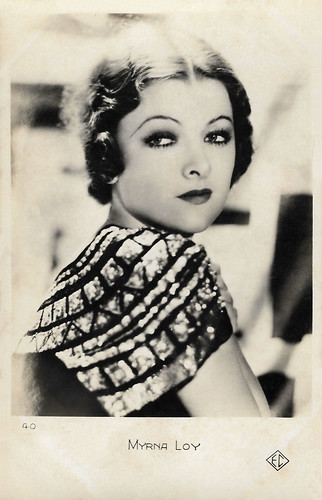
French postcard by Editions Chantal (EC), no. 40. Photo: George Hurrell / Metro-Goldwyn-Mayer, 1932.

British postcard by Film Weekly. Myrna Loy and John Barrymore in Topaze (Harry D'Abbadie D'Arrast, RKO 1933).

British postcard by Art Photo, no. 102. Photo: Metro-Goldwyn-Mayer. Myrna Loy and Wiliam Powell in After the Thin Man (W.S. Van Dyke, 1936).

British Real Photograph postcard by Milton, no. 47. Photo: Metro-Goldwyn-Mayer Pictures.

British Real Photograph postcard, no. 47. A. Photo: Metro-Goldwyn-Mayer Pictures.

British Real Photograph postcard, no. 47. B. Photo: Metro-Goldwyn-Mayer Pictures.
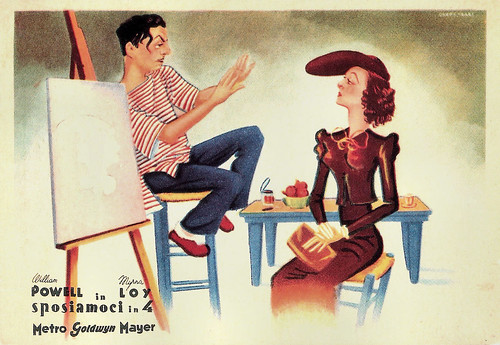
Italian postcard. Artwork: Giacomo Canestrari / Metro-Goldwyn-Mayer. William Powell and Myrna Loy in Double Wedding (1937).

British postcard in the Film Partners Series, London, no. P 249. Photo: Metro-Goldwyn-Mayer. Clark Gable and Myrna Loy in Test Pilot (Victor Fleming, 1938).

British postcard by Valentine's, no. 5904 E. Photo: M.G.M.

French card by Massilia. Photo: Metro-Goldwyn-Mayer. Collection: Amit Benyovits.
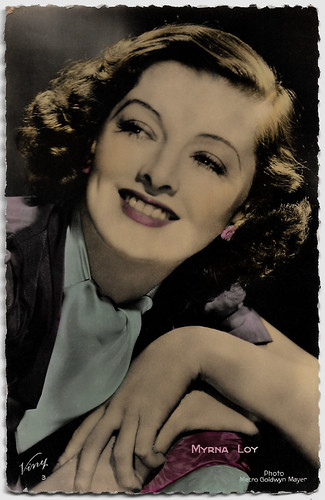
French postcard by Viny, no. 3. Photo: Metro-Goldwyn-Mayer.

Dutch postcard by J.S.A. (J. Sleding, Amsterdam). Photo: Universal / M.P.E.
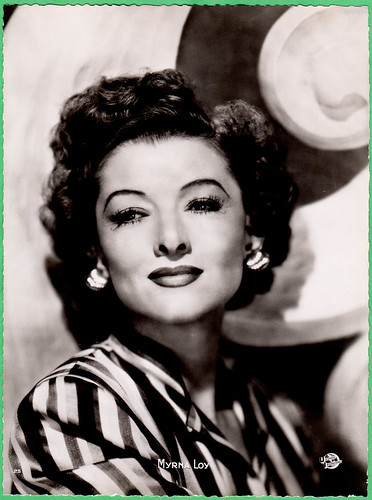
Belgian collector card by Chocolaterie Clovis, Pepinster, no. 25. Photo: Universal-International. Collection: Amit Benyovits.
Sources: Denny Jackson (IMDb), Wikipedia and IMDb.

British postcard in the Picturegoer Series, London, no. 355a.

French postcard by P.C., Paris, no. 38. Photo: George Hurrell, c. 1932 / MGM.

British postcard in the Film Partners Series, London, no. P 161. Photo: Metro-Goldwyn-Mayer. William Powell and Myrna Loy in Evelyn Prentice (William K. Howard, 1934).

German postcard by Ross Verlag, no. A 1496/1, 1937-1938. Photo: Metro-Goldwyn-Mayer.

French postcard by Editions P.I., Paris, no. 234, presented by Victoria, Brussels, no. 639. Photo: Metro Goldwyn Mayer (M.G.M.), 1950.
Portraying vamps
Myrna Loy was born Myrna Adele Williams in 1905 in Helena, Montana. Her parents were Adelle Mae (Johnson) and David Franklin Williams Loy was raised in rural Radersburg during her early childhood. Her mother was a talented pianist who encouraged Myrna's interest in the arts. When she was thirteen, Myrna's father died of influenza in the Spanish Flu epidemic, and the rest of the family moved to Los Angeles.
There, she began studying dance and trained extensively throughout her high school education. At the age of 15, she appeared in local stage productions to help support her family. She appeared in staged prologues before the films in the famous Grauman's Egyptian Theater in Hollywood. During this period, Loy saw Eleonora Duse in the play 'Thy Will Be Done', and the simple acting techniques she employed made such an impact on Loy that she tried to emulate them throughout her career.
Portrait photographer Henry Waxman took several pictures of her that were noticed by Rudolph Valentino when the actor went to Waxman's studio for a sitting. Valentino was looking for a leading lady for Cobra, the first independent project he and his wife Natacha Rambova were producing. Loy tested for the role, which went to Gertrude Olmsted instead. Rambova hired Loy for a small but showy role opposite Nita Naldi in What Price Beauty? (Tom Buckingham, 1925-1928), a film she was producing. Shot in May 1925, the film remained unreleased for three years, but stills of Loy in her exotic makeup and costume appeared in Motion Picture magazine and led to a contract with Warner Bros. There, her surname was changed from Williams to Loy.
At Warner Bros., she began obtaining small roles, mainly portraying vamps or femmes fatales. She appeared along with Zasu Pitts and Joan Crawford in Pretty Ladies (Monta Bell, 1925). She also frequently portrayed characters of Asian or Eurasian background in films such as Across the Pacific (Roy Del Ruth, 1926) starring Monte Blue.
Finally, in 1927, she received star billing in Bitter Apples (Harry O'Hoyt, 1927). The excitement was short-lived as she returned to the usual smaller roles afterward. When her contract ran out with Warner, she signed with MGM where she got better roles.

British Real Photograph postcard by Sarony, no. 40. Photo: Warner Bros. Caption: No. 40 of a second Series of 42 CINEMA STARS issued with Sarony Cigarettes.

Italian postcard by Cinema-Illustrazione, Milano, no. 7, Serie I. Photo: Fox Film. Myrna Loy in Isle of Escape (Howard Bretherton, 1930).

Dutch postcard. Photo: Max Munn Autrey / Fox-Film.

German collector card in the Moderne Schönheitsgalerie series, no 149 (out of 300). The series was produced by Ross Verlag for Kurmark as a supplement for their Edelzigarette. Photo: Metro Goldwyn Mayer (M.G.M.). Myrna Loy in The Mask of Fu Manchu (Charles Brabin, 1932). She played the depraved sadistic daughter of the title character, played by Boris Karloff.

Dutch postcard, no. 484. Photo: Metro-Goldwyn-Mayer. Ramon Novarro and Myrna Loy in The Barbarian (Sam Wood, 1933).
Queen of the movies
Myrna Loy's role in The Thin Man (W.S. Van Dyke, 1934) with William Powell helped elevate her reputation as a versatile actress. Director W.S. Van Dyke chose Loy after he detected a wit and sense of humour that her previous films had not revealed. At a Hollywood party, he pushed her into a swimming pool to test her reaction and felt that her aplomb in handling the situation was exactly what he envisioned for Nora. Her witty perception of situations gave Loy the image that one could not pull a fast one over on the no-nonsense Mrs. Charles.
The Thin Man became one of the year's biggest hits and was nominated for the Academy Award for Best Picture. From then on, Myrna was a big box office draw. She was popular enough that, in 1936, she was named 'Queen of the Movies' and Clark Gable the king in a nationwide poll of filmgoers. She reprised the role of Nora Charles five more times. William Powell and she proved to be a popular screen couple and appeared in 14 films together, one of the most prolific pairings in Hollywood history. Such films as Wife vs. Secretary (Clarence Brown, 1936) with Clark Gable and Jean Harlow, and Petticoat Fever (George Fitzmaurice, 1936) with Robert Montgomery allowed her to develop her comedic skills. She appeared in two Best Picture Academy Award winners: The Great Ziegfeld (Robert Z. Leonard, 1936) and The Best Years of Our Lives (William Wyler, 1946).
With the outbreak of World War II, Loy focused on the war effort and began devoting her time to working with the Red Cross. Earlier, she was so fiercely outspoken against Adolf Hitler that her name appeared on his blacklist, resulting in her films being banned in Germany. After the war, Myrna Loy was paired with Cary Grant in David O. Selznick's The Bachelor and the Bobby-Soxer (Irving Reis, 1947), co-starring a teenaged Shirley Temple. Following its success, she appeared again with Grant in Mr. Blandings Builds His Dream House (H.C. Potter, 1948). Loy's career began to slow in the late 1940s.
She appeared in only a few films in the 1950s, including a lead role in the comedy Cheaper by the Dozen (Walter Lang, 1950) opposite Clifton Webb, as well as supporting parts in The Ambassador's Daughter (Norman Krasna, 1956) and the drama Lonelyhearts (Vincent J. Donehue, 1958), starring Montgomery Clift. ;Later in her career, she was often cast as a maternal, heroic character. In 1973, she made her Broadway debut in a revival of Clare Boothe Luce's 'The Women'. Between 1960 and 1981, she appeared in only eight films, after which she retired from acting. Her last acting role was a guest spot on the sitcom Love, Sidney, in 1982. Her autobiography, 'Myrna Loy: Being and Becoming', was published in 1987.
Although Loy was never nominated for an Academy Award, in March 1991 she received an Honorary Academy Award in recognition of her life's work both onscreen and off, including serving as assistant to the director of the military and Naval welfare for the Red Cross during World War II, and a member-at-large of the U.S. Commission to UNESCO. Myrna Loy died in 1993 in New York City, aged 88. She married and divorced four times. Her husbands were Arthur Hornblow Jr. (1936-1942), John Daniel Hertz Jr. (1942-1944), Gene Markey (1946-1950), and Howland Hill Sargeant (1951-1960).

French postcard by Editions Chantal (EC), no. 40. Photo: George Hurrell / Metro-Goldwyn-Mayer, 1932.

British postcard by Film Weekly. Myrna Loy and John Barrymore in Topaze (Harry D'Abbadie D'Arrast, RKO 1933).

British postcard by Art Photo, no. 102. Photo: Metro-Goldwyn-Mayer. Myrna Loy and Wiliam Powell in After the Thin Man (W.S. Van Dyke, 1936).

British Real Photograph postcard by Milton, no. 47. Photo: Metro-Goldwyn-Mayer Pictures.

British Real Photograph postcard, no. 47. A. Photo: Metro-Goldwyn-Mayer Pictures.

British Real Photograph postcard, no. 47. B. Photo: Metro-Goldwyn-Mayer Pictures.

Italian postcard. Artwork: Giacomo Canestrari / Metro-Goldwyn-Mayer. William Powell and Myrna Loy in Double Wedding (1937).

British postcard in the Film Partners Series, London, no. P 249. Photo: Metro-Goldwyn-Mayer. Clark Gable and Myrna Loy in Test Pilot (Victor Fleming, 1938).

British postcard by Valentine's, no. 5904 E. Photo: M.G.M.

French card by Massilia. Photo: Metro-Goldwyn-Mayer. Collection: Amit Benyovits.

French postcard by Viny, no. 3. Photo: Metro-Goldwyn-Mayer.

Dutch postcard by J.S.A. (J. Sleding, Amsterdam). Photo: Universal / M.P.E.

Belgian collector card by Chocolaterie Clovis, Pepinster, no. 25. Photo: Universal-International. Collection: Amit Benyovits.
Sources: Denny Jackson (IMDb), Wikipedia and IMDb.
No comments:
Post a Comment